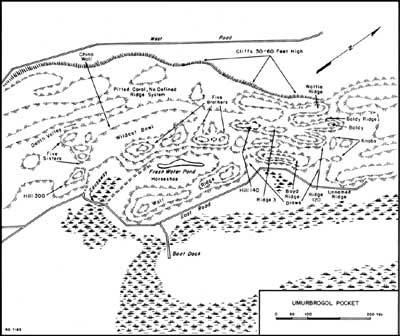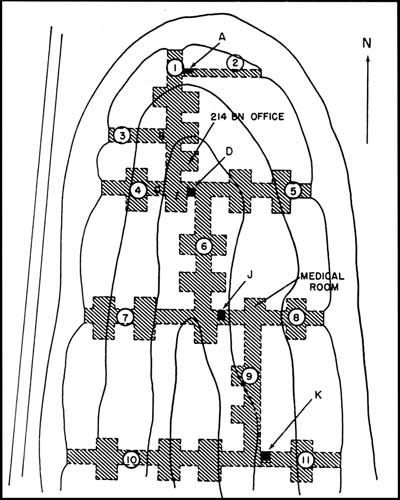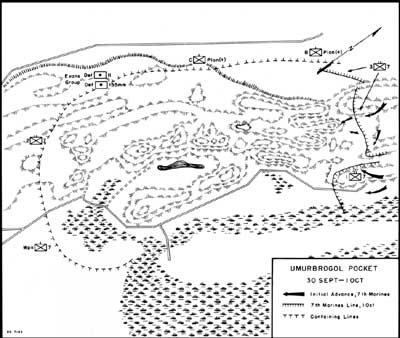| Marines in World War II Commemorative Series |
|
BLOODY BEACHES: The Marines at Peleliu by Brigadier General Gordon D. Gayle, USMC (Ret) The Umurbrogol Pocket: Peleliu's Character Distilled In a very real sense, the Umurbrogol Pocket typified the worst features of the post D-Day campaign for Peleliu. It provided the scene of some of Peleliu's worst and most costly fighting, and of some of the campaign's best and worst tactical judgments. Its terrain was the most difficult and challenging on the island. Prelanding planning did not perceive the Pocket for what it was, a complex cave and ridge fortress suitable to a fanatic and suicidal defense. Plans for the seizure of the area treated the Pocket's complex terrain as oversimplified, time-phased linear objectives to be seized concurrently with the flat terrain abutting it to the east and west. The southern slopes (generally called Bloody Nose) dominated the landing beaches and airfield, over which the Pocket had to be approached. After those heights were conquered by the heroic and costly assaults of Puller's 1st Marines (with Berger's 2/7 attached), and after the division had set in artillery which was controlled by aerial observers overhead, the situation changed radically. The Pocket's defenders there after retained only the capability to harass and delay the Americans, to annoy them with intermittent attacks by fire and with night-time raids. But after D plus 4, Umurbrogol's defenders could no longer seriously threaten the division's mission.
Nevertheless, after the critical enemy observation sites were seized, General Rupertus kept urging "momentum," as though the seizure of the Pocket were as urgent as had been seizure of the commanding heights guarding it from the south. The stubborn character of the terrain, and its determined defenders, became entwined with the determined character of the general commanding the 1st Marine Division. This admixture was sorted out only by time and by the reluctant intercession of General Geiger. Most of the offensive effort into the Pocket between 21 and 29 September was directed from south to north, into the mouths or up onto the ridges of the twin box canyons which defined the Pocket. Infantry, supported by tanks, air, and flame-throwing LVTs could penetrate the low ground, but generally then found themselves surrounded on three sides. Japanese positions inside the ridges of the canyons, hidden from observation and protected in their caves, were quite capable of making the "captured" low ground untenable. Other attacks, aimed at seizing the heights of the eastern ridges, while initially successful, in that small infantry units could scramble up onto the bare ridge tops, thereafter came under fire from facing parallel ridges and caves. They were subject to strong night counterattacks from Japanese who left their caves under cover of darkness. During 20 September, D plus 5, the 7th Marines had relieved the 1st Marines along the south and south west fronts of the Pocket, and on the 21st the 3d and 1st Battalions resumed the attack into the Pocket, from southwest and south. These attacks achieved limited initial successes behind heavy fire support and smoke, but succeeded only in advancing to positions which grew un tenable after the supporting fire and smoke was lifted. Assault troops had to be withdrawn under renewed fire support to approximately their jump off positions. There was little to show for the day's valiant efforts.
Attacks the next day (22 September) against the west shoulder of the Pocket, from the West Road, up the western box canyon (Wildcat Bowl) and toward Higashiyama (Hill 140), all liberally supported with firepower, again produced early advances, most of which had to be surrendered at day's end, as all three attacking groups came under increasing fire from the Japanese hidden in mutually supporting cave positions. The 7th Marines had, unbeknown to it, reached within about 100 yards of Colonel Nakagawa's final command cave position. However, many supporting ridges, and hilltops, would have to be reduced before a direct attack upon that cave could have any hope of success. The fight for Umurbrogol Pocket had devolved into a siege situation, to be reduced only by siege tactics. But the 1st Marine Division's commander continued to cling to his belief that there would be a "break-thru" against the enemy's opposition. He insisted that continued battalion and regimental assaults would bring victory "very shortly." When the 321st's probes eastward near the northern end of the Pocket brought them within grasp of sealing off that Pocket from the north, they deployed two battalions (2d and 3d) facing eastward to complete the encirclement.
This attack against Hill B, the stopper at the northern end of the Pocket absorbed the 321st Infantry's full attention through 26 September, as the 5th Marines was fighting in northern Peleliu. The 7th Marines continued pressuring the Pocket from the south, and guarding it on the west. With the 321st victory on the 26th, that unit's mission was expanded to press into the Pocket from the north. This it did, while simultaneously clearing out the sporadically defended Kamilianlul Ridge to its north. Its attack south from Hill B and adjacent ridges made very limited progress, but permitted some consolidation of the American hold along the north side of the Pocket, now 400 yards wide in that zone. On 29 September, the 7th Marines was ordered to relieve the Army unit in that northern sector. To relieve 2/7 and 3/7 of their now largely static guard positions along the west and southwest sectors of the Pocket, the division stripped hundreds of non-infantry from combat support units (artillery, engineer, pioneer), and formed them into two composite "infantillery" units. Under 11th Marines' Lieutenant Colonel Richard B. Evans and 5th Marines' Major Harold T. A. Richmond, they were assigned to maintain the static hold in the sectors earlier held by 2/7 and 3/7. They faced the karst plateau between the West Road and the Pocket . The 7th Marines' flexibility restored by this relief, its 1st and 3d Battalions relieved the 321st units on 29 September, along the north edge of the Pocket. Then on the 30th, they pushed south, securing improved control of Boyd Ridge and its southern extension, variously called Hill 100, Pope's Ridge, or Walt Ridge. The latter dominated the East Road, but Japanese defenders remained in caves on the west side. The 7th Marines' partial hold on Pope Ridge gave limited control of East Road, and thereby stabilized the east side of the Pocket. But the U.S. hold over the area needed improvement, On 3 October, reinforced by the attached 3/5 (back from Ngesebus), the 7th Regiment organized a four-battalion attack. The plan called for 1/7 and 3/7 to attack from the north, against Boyd Ridge and the smaller ridges to its west, while 2/7 would attack Pope (Walt) Ridge from the south. The attached 3/5 was ordered to make a diversionary attack from the south into the Horseshoe canyon and its guardian Five Sisters on its west. This regimental attack against the Pocket committed four infantry "battalions," all now closer to company than battalion strength, against the heights near the southern end of the Pocket (Five Sisters), and the ridges at the eastern shoulder of the Pocket (Pope and Boyd Ridges). After heavy casualties, the attack succeeded, but the Five Sisters (four of which 3/5 scaled) were untenable, and had to be abandoned after their seizure. The next day, 4 October, the 7th Marines with 3/5 still attached made one more general attack — in the south, again to seize, then give up, positions on the Five Sisters; in the north, to try to advance and consolidate the positions there earlier seized.
In that 4 October action, the 3d Battalion, 7th Marines' push led to an unexpectedly rapid advance which it pressed to get up onto Hill 120. It was hoped that this would provide a good jump-off for the next day's operation against the next ridge to the west. However, Hill 120, as with so many others in the Umurbrogol, was then under enemy crossfire which made it completely untenable. The attacking company was with drawn with heavy casualties. Among these casualties was Captain James V. "Jamo" Shanley, commanding Company L. His company was attacking Ridge/Hill 120 when several of his men fell, wounded. Shanley dashed forward under heavy fire, rescued two of the men and brought them to safety behind a tank. He then rushed back to help a third, when a mortar round landed immediately behind him, mortally wounding him. His executive officer, Lieutenant Harold J. Collins ran out to rescue him, only to fall by his side instantly killed by a Japanese anti tank round. For his heroism Captain Shanley was awarded a Gold Star (second) for the Navy Cross he had earned at Cape Gloucester, New Britain. There, his company was in the lead in seizing Hill 660, a key terrain feature in the Borgen Bay area. The 7th Marines had now been in the terrible Umurbrogol struggle for two weeks. General Rupertus decided to relieve it, a course General Geiger also suggested. Still determined to se cure the Pocket with Marines, General Rupertus turned to his only remaining Marine regiment, the 5th.
|






